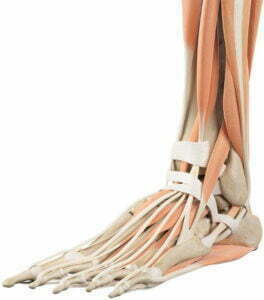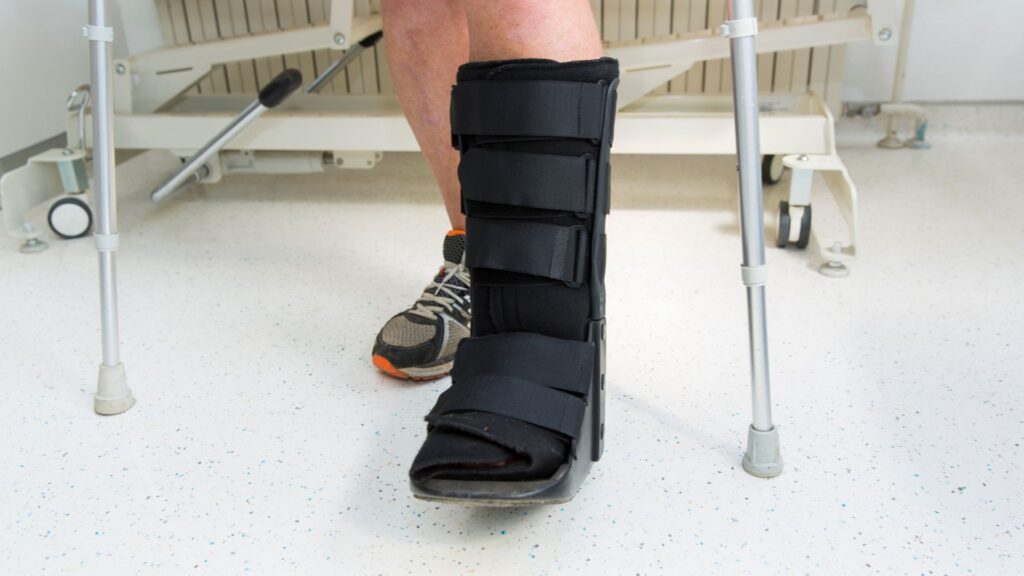About
Anatomy of the Foot

The foot is a complex structure made up of 26 bones, 33 joints, and numerous muscles, ligaments, and tendons. The bones are divided into three groups: the tarsal bones, which form the heel and ankle; the metatarsal bones, which make up the midfoot; and the phalanges, the bones of the toes. These bones work together to support the body’s weight and allow for movement and balance.
Mechanism of Injury
Foot fractures occur due to direct or indirect force applied to the bones. Direct force could result from a heavy object falling on the foot, while indirect force might involve twisting or rolling the foot. John’s injury, for instance, was caused by landing awkwardly after jumping to catch the ball.
Types of Foot Fractures
There are several types of foot fractures, including:
- Avulsion fractures: A small piece of bone is pulled off by a ligament or tendon. This type of fracture is common in sports like basketball and soccer.
- Jones fractures: Occur at the base of the fifth metatarsal, near the small toe. These fractures are often caused by twisting the foot or ankle.
- Lisfranc fractures: Involve the midfoot, where the long metatarsal bones connect to the tarsal bones. High-impact sports, falls, and car accidents can lead to this fracture.
- Stress fractures: Small cracks in the bone, often due to overuse or repetitive force. Runners and dancers are particularly susceptible to stress fractures.
- Open fractures: Occur when the bone breaks and pierces through the skin, increasing the risk of infection.
John was diagnosed with a Jones fracture, which required immediate attention.
Exploring Fractures of Specific Foot Bones: A Closer Look
Each of the 26 bones in the foot plays a crucial role in supporting our body weight, balance, and movement. When fractures occur in these bones, it can be quite debilitating. Let’s delve into some specific foot bones and the fractures that can affect them.
Calcaneus Fractures: The Heel Bone
The calcaneus, or heel bone, is the largest bone in the foot and plays a vital role in supporting our body weight. Fractures of the calcaneus typically result from high-energy impacts, such as a fall from a height or a motor vehicle accident. Symptoms may include severe pain, swelling, and difficulty walking. Treatment can range from immobilization and rest to surgery, depending on the severity and alignment of the fracture.
Talus Fractures: The Ankle Pivot
The talus bone, situated between the heel bone and the lower leg bones, is an essential pivot point in the ankle. Talus fractures are relatively uncommon and usually occur due to high-energy impacts or severe ankle twists. Symptoms include pain, swelling, and limited ankle movement. Treatment may involve immobilization, reduction (realignment of the bone), or surgery, depending on the severity and location of the fracture.
Metatarsal Fractures: The Midfoot Bridge
The five metatarsal bones form the midfoot and can be fractured due to direct impact, twisting injuries, or stress from overuse. Common types of metatarsal fractures include:
- Lisfranc fracture: A fracture or dislocation in the midfoot where the metatarsal bones connect to the tarsal bones. This injury often results from high-impact sports, falls, or car accidents and can cause significant pain, swelling, and bruising.
- Dancer’s fracture: A spiral fracture of the fifth metatarsal, which occurs when the foot rolls inward while the ankle simultaneously turns outward. It is common in dancers and athletes.
- Stress fracture: A small crack in a metatarsal bone, often resulting from overuse or repetitive force. Runners and dancers are particularly susceptible to stress fractures.
Treatment for metatarsal fractures depends on the type and severity of the injury and may include immobilization, reduction, or surgery.
Phalange Fractures: The Toe Bones
The 14 phalanges, or toe bones, can be fractured due to direct impact (such as stubbing the toe) or by dropping a heavy object on the foot. Symptoms include pain, swelling, bruising, and deformity. Most toe fractures can be managed conservatively with buddy taping (taping the injured toe to an adjacent healthy toe) and wearing a stiff-soled shoe. However, if the fracture is displaced or involves the joint, surgery may be necessary.
In conclusion, fractures of specific foot bones can have a significant impact on mobility and daily life. Early diagnosis and appropriate treatment are crucial for optimal recovery and minimizing complications. If you suspect a foot fracture, seek prompt medical attention to ensure the best possible outcome.
Diagnosis
Symptoms and Signs of a Foot Fracture
The common symptoms of a foot fracture include:
- Pain, which may be severe and worsen with movement or pressure
- Swelling and bruising around the injured area
- Difficulty walking or bearing weight on the affected foot
- Deformity, in some cases
John experienced sharp pain, swelling, and difficulty walking after his injury, prompting him to seek help at Urgent Care Brisbane.
Examination and X-ray
At Urgent Care Brisbane, John underwent a thorough examination, during which the doctor assessed his foot for tenderness, swelling, and deformity. An X-ray was performed to confirm the diagnosis and determine the severity of the fracture. In some cases, a CT scan or MRI may be needed for a more detailed evaluation.
Treatment
Management and Complications
Treatment for a foot fracture depends on the type, location, and severity of the injury. In John’s case, non-surgical treatment was recommended. The doctor applied a splint to immobilize the foot and reduce swelling. John was instructed to keep his foot elevated and apply ice packs for 20 minutes every few hours.
He was also provided with a moon boot to stabilize his foot and crutches for support while walking

Pain medication and anti-inflammatory drugs were prescribed to manage John’s discomfort and reduce inflammation.
In some instances, surgery may be necessary to repair the fracture, especially if the bones are misaligned or the fracture is unstable. Complications associated with foot fractures can include:
- Infection, particularly in open fractures
- Delayed or improper healing
- Arthritis or joint damage
- Nerve or blood vessel injury
- Chronic pain or stiffness
To prevent these complications, it is crucial to follow the treatment plan and recommendations provided by the healthcare team.
How Urgent Care Brisbane Helped John
Urgent Care Brisbane offers a comprehensive approach to managing foot fractures without the need for a hospital emergency visit. Their facility is equipped with on-site radiology for quick and accurate diagnosis. The skilled medical team is capable of performing closed reduction, which involves realigning the bones without surgery, and casting using synthetic materials.
John benefited from the availability of moon boots and crutches, which allowed him to remain mobile while his foot healed. Urgent Care Brisbane also provided follow-up appointments to monitor John’s progress and ensure proper healing.
With the dedicated care he received at Urgent Care Brisbane, John was able to make a full recovery and return to his active lifestyle. His experience demonstrates the importance of timely intervention and appropriate treatment for foot fractures.
In Conclusion
Foot fractures can result from various causes, ranging from sports injuries to accidents. Understanding the anatomy, mechanism of injury, types of fractures, symptoms, and signs is crucial for timely diagnosis and management. Urgent Care Brisbane offers a comprehensive solution to patients with foot fractures, providing on-site radiology, closed reduction, casting, and follow-up care without the need for a hospital emergency visit.
If you or a loved one experiences a foot fracture, consider seeking help at Urgent Care Brisbane for expert care and a faster path to recovery. Remember, timely intervention and appropriate treatment can make all the difference in the healing process and long-term outcomes.
Next Steps
Visit Urgent Care Brisbane for Expert Foot Fracture Care
If you suspect a foot fracture, don’t hesitate to visit Urgent Care Brisbane for a prompt and accurate diagnosis. Their team of experienced professionals is dedicated to providing exceptional care in a comfortable setting, ensuring you receive the treatment you need without the stress of a hospital emergency room. Take the first step towards recovery and regain your mobility by visiting Urgent Care Brisbane today. Your feet will thank you!

